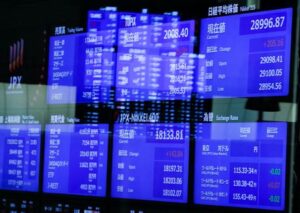By Lucia Mutikani
WASHINGTON (Reuters) – U.S. consumer sentiment sagged to a six-month low in May as households worried about the higher cost of living and unemployment, but economists cautioned against drawing conclusions on the implications for the economic outlook.
The larger-than-expected drop in sentiment reported by the University of Michigan on Friday was across all age, income and education groups as well political party affiliation.
“Consumer confidence is volatile on a month-to-month basis and has not been an important driver of consumer spending in recent years,” said Michael Pearce, deputy chief U.S. economist at Oxford Economics.
“The resilience of consumer spending is dependent on the strong state of household balance sheets and the robust labor market. Only if the latter begins to falter would we expect to see more meaningful signs of economic weakness emerge.”
The University of Michigan’s preliminary reading on the overall index of consumer sentiment came in at 67.4 this month, the lowest level since last November, compared to a final reading of 77.2 in April. Economists polled by Reuters had forecast a preliminary reading of 76.0.
They estimated that the University of Michigan’s ongoing transition to web-based interviews from telephone surveys had knocked about 2 points off the headline index this month.
Economic growth slowed in the first quarter and employers hired the fewest number of workers in six months in April, recent data showed. University of Michigan Surveys of Consumers Director Joanne Hsu said consumers “expressed worries that inflation, unemployment and interest rates may all be moving in an unfavorable direction in the year ahead.”
With gasoline prices pretty much stable in recent weeks and stock market prices mostly trending higher, economists were at a loss to explain the rest of the drop in sentiment.
“It is hard to explain given that …. there is little evidence of any major downturn in the labor market. Households could also still be reacting to the earlier selloff in equities around mid-April,” said Paul Ashworth, chief North America economist at Capital Economics.
“It could also be due to other non-economic factors like the upcoming election, the brief Israel-Iran conflict or the spread of pro-Palestinian protests across college campuses. It might simply be noise rather than signal.”
The mood was downbeat among Democrats, independents and Republicans.
Stocks on Wall Street were mixed. The dollar rose against a basket of currencies. U.S. Treasury prices fell.
HIGH INFLATION
The survey’s reading of one-year inflation expectations rose to 3.5% in May from 3.2% in April, remaining above the 2.3%-3.0% range seen in the two years prior to the COVID-19 pandemic.
Its five-year inflation outlook increased to 3.1% from 3.0% in the prior month. While long-run inflation expectations have been within the narrow 2.9%-3.1% range for 30 of the last 34 months, they remain high relative to the 2.2-2.6% range seen in the two years pre-pandemic.
Inflation reaccelerated in the first quarter, but economists believe the disinflation trend will reassert itself in the second quarter as domestic demand cools in response to 525 basis points worth of interest rate hikes from the Federal Reserve since March 2022.
Inflation data next week is expected to show consumer prices moderating in April after three straight months of strong readings. Financial markets expect the U.S. central bank to start its easing cycle in September. But some economists are skeptical as inflation remains way above the Fed’s 2% target.
The central bank last week left its benchmark overnight interest rate unchanged in the current 5.25%-5.50% range, where it has been since July.
“The Fed is unlikely to cut rates, absent the onset of recession, unless inflation is clearly headed sustainably to 2%,” Conrad DeQuadros, senior economic advisor at Brean Capital. “Anchored inflation expectations are a key part of this assessment and a 3.1% longer-term expectation is near the high end of the range that the Fed judges as being anchored.”
(Reporting by Lucia Mutikani; Editing by Chizu Nomiyama)





